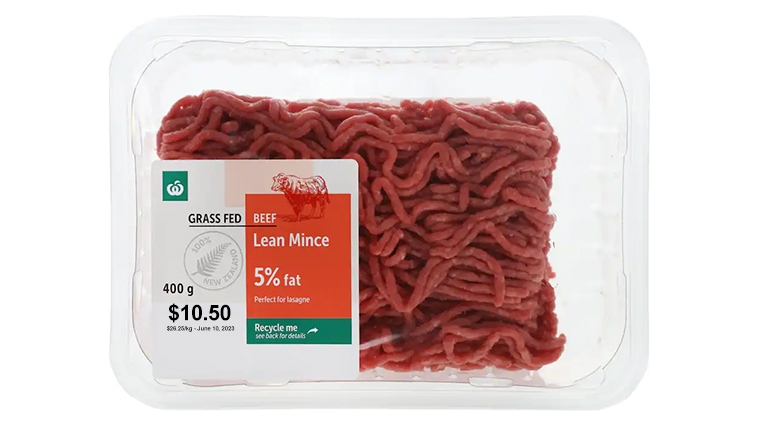
This week AgResearch senior scientist Cameron Craigie is discussing some research on New Zealand meat consumption.
More than nine out of ten New Zealanders are meat-eaters, a survey has found; though almost half of Kiwis have reduced their meat consumption in response to issues such as cost and health. The results of the online survey carried out in December 2021 – along with an associated review led by crown research institute AgResearch - also shows high awareness of meat alternatives, but a “very low” level of consumption of those alternative products.
“Overall, the outlook for meat consumption and (the) meat industry in New Zealand is positive and is likely to remain so for the foreseeable future,” says the recently published study from AgResearch scientists and Lincoln University researchers. The online survey of 1061 New Zealand consumers found that for meat-eaters “the taste of meat is the king decider for purchase and consumption”; with 71 per cent rating taste a “very important” attribute when purchasing, followed by price (55 per cent) and use-by date (51 per cent).
Results showed that chicken was the main type of meat consumed regularly, accounting for about 33 per cent of the meals within an average week, followed by beef (22 per cent), fish (13 per cent), pork (10 per cent), lamb (8 per cent), and processed meat (7 per cent). Plant-based meat products, venison, game/hunted meat, and other meat types only make up a minor portion in participants' weekly diets (Iess than 2 per cent). Over the past year, nearly half of survey respondents (47 per cent) lowered their meat consumption; most of them (69 per cent) had consumed less meat overall while the rest of meat reducers (31 per cent) only lowered the consumption of particular meat products. When it came to motivations for reducing meat consumption, “lack of affordability and health concerns are their key drivers”. Survey participants were also asked to indicate the top 3 factors or words that they considered important to define sustainability for meat production.
The most frequent terms include ‘animal welfare’, ‘environmental impact’ and ‘grass-fed’, closely followed by ‘carbon/GHG emissions’, ‘free range’ and ‘farming methods’.
Consumers acknowledged the importance of sustainability linked to care for animals and the environment and were willing to pay a premium (17–24%) for a range of meat attributes associated with these social aspects. Although the respondents' awareness of alternative proteins or meat alternatives was high, their consumption of these products was rated as very low compared to what is reported in other countries.
AgResearch senior scientist Cameron Craigie says the headline survey result on omnivorous diets is not necessarily surprising given the value and tradition of meat eating in New Zealand. Affordability issues were likely to have remained to the fore with the higher inflation since the survey was completed, with April 2023 meat, poultry and fish prices up 9.5 per cent on the NZ food price index compared to April 2022.
“The survey is a snapshot in time, but for us as researchers, it does help us focus on the research that addresses the issues that people care most about. Clearly taste is a key factor for meat eaters and that’s why we are doing research to help producers maximise that.” The value or impacts of meat in a diet has recently been the subject of several reports internationally, including the Food and Agriculture Organisation of the United Nations (FAO) stating that “meat, eggs and milk offer crucial sources of much needed nutrients which cannot easily be obtained from plant-based foods”.
Dr Craigie says a discussion based on the scientific evidence is important when it comes to health or sustainability. “On the sustainability front, we know this is something consumers are concerned about, and we are working with farmers to help provide them tools and practices to reduce their environmental impact and meet targets around things like water quality and climate change.”
Not only does eating meat support NZ farmers but there are of course nutritional benefits, lamb and beef provides an efficient source of complete protein, all essential amino acids, vitamin B12, and zinc.
One of the challenges that Craigie points out is price point, we need to be conscious of the fact that what the consumer pays at the checkout, it is a fraction of what the farmer receives, at the moment a farmer is receiving around $5.50/kg for processed prime cattle from the freezing works, lamb is returning between $7.20-$7.50/kg. Premium beef mince at Pack In Save is selling for about $22/kg with fillet steak fetching around $38/kg. Lamb mince will set you back $20/kg and a lamb rack is around $57/kg.
Now of course there are many hands meat goes through to get to the checkout, but you have to wonder how much of a role a lack of supermarket competition in this country is playing in high meat prices at the checkout. Something must give at the retail level, either through legislation or increased market competition, the duopoly that we currently have in New Zealand does nothing to support communities in getting a fair deal for food, and it certainly does not help farmgate returns, both of which play a significant role in ensuring a healthy New Zealand economy into the future.
Listen to the podcast to hear the full story.
Angus Kebbell is the Producer at Tailwind Media. You can contact him here.
6 Comments
Now of course there are many hands meat goes through to get to the checkout, but you have to wonder how much of a role a lack of supermarket competition in this country is playing in high meat prices at the checkout.
It'd actually be really helpful if you found out. Because the chain would go:
-transport animal to meatworks
-slaughter animal halal style to make it internationally marketable
-process carcass into cuts of meat
-transport the leftovers (refrigerated)
-package meat
-refrigerate it some more
-retail the meat
-add some GST
And likely a few other steps I'm unaware of. And at every step of the way, wages and fuel have increased a fair bit.
But those steps in the chain have pretty much always existed. It's not like refrigerating the meat is a new thing here or globally. Each step of the way has seen wages and fuel increase, but it's not a compounding increase. The increase should be relative to the increase of the fractional costs.
Not necessarily. We don't know for instance whether there is additional extenuating issues along the chain. Is everything running at maximum capacity? Or are supply chains taking longer to fulfil the same volume?
The fact supermarkets are in still showing empty spaces should be telling you something.
We just focus on the retailing, because that's the aspect most people are familiar with.
Can confirm that slaughterhouse costs went up recently in the top of the south, prompting an increase in retail prices and at all restaurants in the region. Confirmed by a local butcher
Apart from energy and wages where else can their costs have increased? Have there been health and safety changes? Packaging and/or storage cost increases? Waste disposal increases? What costs do they have in their processing that the consumer doesn't know about?
1. The consumer pays 15% GST on the whole amount of costs - they cant claim it back so its not 15% on the farmer share alone but everyone so the % is the same but the total amount is larger. As the pre GST number gets bigger the GST share gets bigger - in real terms GST on $12 + GST is much lower than GST on $20 +GST - consumer pays on the whole supply chain costs. (The danger of % watching when total $$ is the important number)
2. We dont know what each sector has in terms of cost increases and the ability to pass on but many past the farmer can do other things or have choice or the next part of the chain just has to pay - trucking different stuff etc, what a super market sells - red meat or chicken etc and can pass it on.
Farmers have no choice - they only have what they have to sell and are in competition with alternatives and consumers scare $$
In simple terms when we go the supermarket we just see a price and the higher it is the more interested we are to look elsewhere or substitute. Basic economic principal and why industries have disappeared over the years and cheaper alternatives appear and take over.(Im not saying the meat industry is doomed!!! - just its got competition and it gets harder as prices rise - the concept applies to everything and ultimately sorts the problem out one way or the other - not a pleasant journey for some though)
Also highlights the evils of inflation and why we need to stamp on it hard.
As JFK said - Farmers buy retail, sell wholesale and pay for the freight both ways!!!

We welcome your comments below. If you are not already registered, please register to comment
Remember we welcome robust, respectful and insightful debate. We don't welcome abusive or defamatory comments and will de-register those repeatedly making such comments. Our current comment policy is here.